Statistical Characteristics of Cloud Occurrence and Vertical Structure Observed by a Ground-Based Ka-Band Cloud Radar in South Korea
Abstract
1. Introduction
2. Data
3. Methods
3.1. Quality Control and Reflectivity Calibration
3.2. Classification of Cloud Types and Their Properties
4. Results
4.1. Reflectivity Calibration
4.2. Seasonal Variation of Cloud Properties
4.3. Diurnal Variation of Clouds
4.4. Characteristics of Vertical Profiles
5. Discussions
6. Conclusions
Author Contributions
Funding
Acknowledgments
Conflicts of Interest
Abbreviations
| 2DVD | 2-dimensional video disdrometer |
| CFAD | Contoured frequency by altitude diagram |
| HC | High cloud |
| LC | Low cloud |
| LDR | Linear depolarization ratio |
| MC | Middle cloud |
| MRR | Micro rain radar |
| PARSIVEL | Particle size and velocity |
| RainDP | Rain deep cloud |
| RainSH | Rain shallow cloud |
| VD | Doppler velocity |
| VertiX | Vertically pointing X-band radar |
| Z | Reflectivity |
References
- Clothiaux, E.E.; Ackerman, T.P.; Mace, G.G.; Moran, K.P.; Marchand, R.T.; Miller, M.A.; Martner, B.E. Objective Determination of Cloud Heights and Radar Reflectivities Using a Combination of Active Remote Sensors at the ARM CART Sites. J. Appl. Meteorol. 2000, 39, 645–665. [Google Scholar] [CrossRef]
- Wagner, T.J.; Kleiss, J.M. Error characteristics of ceilometer-based observations of cloud amount. J. Atmos. Ocean. Technol. 2016, 33, 1557–1567. [Google Scholar] [CrossRef]
- Kollias, P.; Tselioudis, G.; Albrecht, B.A. Cloud climatology at the Southern Great Plains and the layer structure, drizzle, and atmospheric modes of continental stratus. J. Geophys. Res. Atmos. 2007, 112, 1–15. [Google Scholar] [CrossRef]
- Chandra, A.S.; Kollias, P.; Giangrande, S.E.; Klein, S.A. Long-term observations of the convective boundary layer using insect radar returns at the SGP ARM climate research facility. J. Clim. 2010, 23, 5699–5714. [Google Scholar] [CrossRef]
- Wood, C.R.; O’Connor, E.J.; Hurley, R.A.; Reynolds, D.R.; Illingworth, A.J. Cloud-radar observations of insects in the UK convective boundary layer. Meteor. Appl. 2009, 16, 491–500. [Google Scholar] [CrossRef]
- Lohmeier, S.P.; Sekelsky, S.M.; Firda, J.M.; Sadowy, G.A.; Mclntosh, R.E. Classification of particles in stratiform clouds using the 33 and 95 ghz polarimetric cloud Profiling Radar System (CPRS). IEEE Trans. Geosci. Remote Sens. 1997, 35, 256–270. [Google Scholar] [CrossRef]
- Luke, E.P.; Kollias, P.; Johnson, K.L.; Clothiaux, E.E. A technique for the automatic detection of insect clutter in cloud radar returns. J. Atmos. Ocean. Technol. 2008, 25, 1498–1513. [Google Scholar] [CrossRef]
- Martner, B.E.; Moran, K.P. Using cloud radar polarization measurements to evaluate stratus cloud and insect echoes. J. Geophys. Res. Atmos. 2001, 106, 4891–4897. [Google Scholar] [CrossRef]
- Zheng, J.; Liu, L.; Chen, H.; Gou, Y.; Che, Y.; Xu, H.; Li, Q. Characteristics of Warm Clouds and Precipitation in South China during the Pre-Flood Season Using Datasets from a Cloud Radar, a Ceilometer, and a Disdrometer. Remote Sens. 2019, 11, 3045. [Google Scholar] [CrossRef]
- Lee, G.W.; Zawadzki, I. Radar calibration by gage, disdrometer, and polarimetry: Theoretical limit caused by the variability of drop size distribution and application to fast scanning operational radar data. J. Hydrol. 2006, 328, 83–97. [Google Scholar] [CrossRef]
- Gage, K.S.; Williams, C.R.; Johnston, P.E.; Ecklund, W.L.; Cifelli, R.; Tokay, A.; Carter, D.A. Doppler Radar Profilers as Calibration Tools for Scanning Radars. J. Appl. Meteorol. 2000, 39, 2209–2222. [Google Scholar] [CrossRef]
- Görsdorf, U.; Lehmann, V.; Bauer-Pfundstein, M.; Peters, G.; Vavriv, D.; Vinogradov, V.; Volkov, V. A 35-GHz polarimetric doppler radar for long-term observations of cloud parameters-description of system and data processing. J. Atmos. Ocean. Technol. 2015, 32, 675–690. [Google Scholar] [CrossRef]
- Tridon, F.; Battaglia, A.; Kollias, P.; Luke, E.; Williams, C.R. Signal Postprocessing and Reflectivity Calibration of the Atmospheric Radiation Measurement Program 915-MHz Wind Profilers. J. Atmos. Ocean. Technol. 2013, 30, 1038–1054. [Google Scholar] [CrossRef][Green Version]
- Dong, X.; Xi, B.; Crosby, K.; Long, C.N.; Stone, R.S.; Shupe, M.D. A 10 year climatology of Arctic cloud fraction and radiative forcing at Barrow, Alaska. J. Geophys. Res. Atmos. 2010, 115, 1–14. [Google Scholar] [CrossRef]
- Lazarus, S.M.; Krueger, S.K.; Mace, M.M. A Cloud Climatology of the Southern Great Plains ARM CART. J. Clim. 2000, 13, 1762–1775. [Google Scholar] [CrossRef]
- Kalesse, H.; Kollias, P. Climatology of High Cloud Dynamics Using Profiling ARM Doppler Radar Observations. J. Clim. 2013, 26, 6340–6359. [Google Scholar] [CrossRef]
- Zhang, J.; Chen, H. Macrophysical properties of specific cloud types from radiosonde and surface active remote sensing measurements over the ARM Southern Great Plains site. Atmos. Ocean. Sci. Lett. 2017, 2834, 1–7. [Google Scholar] [CrossRef]
- Lamer, K.; Kollias, P.; Nuijens, L. Observations of the variability of shallow trade wind cumulus cloudiness and mass flux. J. Geophys. Res. Atmos. 2015, 120, 6161–6178. [Google Scholar] [CrossRef]
- Kim, M.; Hong, S. Seasonal Change of the Frequency Percentage of Cloud Occurrence According to Its Type, Height and Amount in Korea. Asia-Pac. J. Atmos. Sci. 1991, 27, 353–364, (In Korean with English abstract). [Google Scholar]
- Yeh, S.-W.; Kim, K.; Shin, K. Relationship between cloud type, cloudiness, surface temperature, and precipitation. In Proceedings of the Spring Meeting of the Korean Meteorological Society, Busan, South Korea, 24–25 April 1997; Korean Meteorological Society: Seoul, Korea, 1997; pp. 155–159. (In Korean) [Google Scholar]
- Song, H.J.; Sohn, B.J. Two heavy rainfall types over the Korean Peninsula in the humid East Asian summer environment: A satellite observation study. Mon. Weather Rev. 2015, 143, 363–382. [Google Scholar] [CrossRef]
- Cho, Y.-H.; Kim, K.-H.; Ha, J.-C.; Lim, E. Occurrence of cloud base height using ceilometer in Boseong, Korea. In Proceedings of the Autumn Meeting of the Korean Meteorological Society, Jeju, South Korea, 12–14 October 2015; Korean Meteorological Society: Seoul, Korea, 2015; pp. 262–263. (In Korean) [Google Scholar]
- Lee, S.; Hwang, S.O.; Kim, J.; Ahn, M.H. Characteristics of cloud occurrence using ceilometer measurements and its relationship to precipitation over Seoul. Atmos. Res. 2018, 201, 46–57. [Google Scholar] [CrossRef]
- Oh, S.B.; Kim, Y.H.; Kim, K.H.; Cho, C.H.; Lim, E. Verification and correction of cloud base and top height retrievals from Ka-band cloud radar in Boseong, Korea. Adv. Atmos. Sci. 2016, 33, 73–84. [Google Scholar] [CrossRef]
- Ye, B.-Y.; Lee, G.; Kwon, S.; Lee, H.-W.; Ha, J.-C.; Kim, Y.-H. Preliminary Analysis of Data Quality and Cloud Statistics from Ka-Band Cloud Radar. Atmosphere 2015, 25, 19–30, (In Korean with English abstract). [Google Scholar] [CrossRef]
- Oh, S.; Won, H.Y.; Ha, J.; Chung, K. Comparison of Cloud Top Height Observed by a Ka-band Cloud Radar and COMS. Atmosphere 2014, 24, 39–48, (In Korean with English abstract). [Google Scholar] [CrossRef]
- Korea Meteorological Administration (KMA). Analysis Report of Climate Change in Boseong-gun, Jeollanam-do. Seoul, South Korea, 2015; 11-1360000-001180-01, p. 62. Available online: http://www.climate.go.kr/home/cc_data/scenario_web_report/Jeonnam_Boseong.pdf (accessed on 10 July 2020). (In Korean).
- Park, S.-G.; Lee, G. Calibration of radar reflectivity measurements from the KMA operational radar network. Asia-Pac. J. Atmos. Sci. 2020, 46, 243–259. [Google Scholar] [CrossRef]
- Chang, W.-Y.; Lee, G.; Jou, B.J.-D.; Lee, W.-C.; Lin, P.-L.; Yu, C.-K. Uncertainty in Measured Raindrop Size Distributions from Four Types of Collocated Instruments. Remote Sens. 2020, 12, 1167. [Google Scholar] [CrossRef]
- Lee, G.W.; Zawadzki, L. Variability of drop size distributions: Noise and noise filtering in disdrometric data. J. Appl. Meteorol. 2005, 44, 634–652. [Google Scholar] [CrossRef]
- Tokay, A.; Bashor, P.G.; Wolff, K.R. Error Characteristics of Rainfall Measurements by Collocated Joss–Waldvogel Disdrometers. J. Atmos. Ocean. Technol. 2005, 22, 513–527. [Google Scholar] [CrossRef]
- Thurai, M.; Gatlin, P.; Bringi, V.N.; Petersen, W.; Kennedy, P.; Notaroš, B.; Carey, L. Toward completing the raindrop size spectrum: Case studies involving 2D-video disdrometer, droplet spectrometer, and polarimetric radar measurements. J. Appl. Meteorol. Clim. 2017, 56, 877–896. [Google Scholar] [CrossRef]
- Kruger, A.; Krajewski, W.F. Two-Dimensional Video Disdrometer: A Description. J. Atmos. Ocean. Technol. 2002, 19, 602–617. [Google Scholar] [CrossRef]
- Marshall, J.S.; Palmer, W.M.K. The distribution of raindrops with size. J. Meteor. 1948, 5, 165–166. [Google Scholar] [CrossRef]
- Mishchenko, M.I.; Travis, L.D.; Mackowski, D.W. T-matrix computations of light scattering by nonspherical particles: A review. J. Quant. Spectrosc. Radiat. Transf. 1996, 55, 535–575. [Google Scholar] [CrossRef]
- Thurai, M.; Huang, G.J.; Bringi, V.N.; Randeu, W.L.; Chönhuber, M. Drop shapes, model comparisons, and calculations of polarimetric radar parameters in rain. J. Atmos. Ocean. Technol. 2007, 24, 1019–1032. [Google Scholar] [CrossRef]
- Yuter, S.E.; Houze, R.A., Jr. Three-Dimensional Kinematic and Microphysical Evolution of Florida Cumulonimbus. Part II: Frequency Distributions of Vertical Velocity, Reflectivity, and Differential Reflectivity. Mon. Weather Rev. 1995, 123, 1941–1963. [Google Scholar] [CrossRef]
- Zawadzki, I.; Szyrmer, W.; Bell, C.; Fabry, F. Modeling of the melting layer. Part III: The density effect. J. Atmos. Sci. 2005, 62, 3705–3723. [Google Scholar] [CrossRef]
- Protat, A.; Williams, C.R. The Accuracy of Radar Estimates of Ice Terminal Fall Speed from Vertically Pointing Doppler Radar Measurements. J. Appl. Meteor. Climatol. 2011, 50, 2120–2138. [Google Scholar] [CrossRef]
- Kalesse, H.; Kollias, P.; Szyrmer, W. On using the relationship between Doppler velocity and radar reflectivity to identify microphysical process in midlatitudinal ice clouds. J. Geophys. Res. Atmos. 2013, 118, 12168–12179. [Google Scholar] [CrossRef]
- Cai, H.; Feng, X.; Chen, Q.; Sun, Y.; Wu, Z.; Tie, X. Spatial and Temporal Features of the Frequency of Cloud Occurrence over China Based on CALIOP. Adv. Meteorol. 2017, 2017. [Google Scholar] [CrossRef]
- Zhang, Y.; Zhou, Q.; Lv, S.; Jia, S.; Tao, F.; Chen, D.; Guo, J. Elucidating cloud vertical structures based on three-year Ka-band cloud radar observations from Beijing, China. Atmos. Res. 2019, 222, 88–99. [Google Scholar] [CrossRef]
- Hong, S.-Y.; Lee, J.-W. Assessment of the WRF model in reproducing a flash-flood heavy rainfall event over Korea. Atmos. Res. 2009, 93, 818–831. [Google Scholar] [CrossRef]
- Jo, E.; Park, C.; Son, S.; Roh, J.-W.; Lee, G.-W.; Lee, Y.-H. Classification of Localized Heavy Rainfall Events in South Korea. Asia-Pac. J. Atmos. Sci. 2020, 56, 77–88. [Google Scholar] [CrossRef]
- Lee, T.-Y.; Kim, Y.-H. Heavy Precipitation Systems over the Korean Peninsula and their Classification. J. Korean Meteor. Soc. 2007, 43, 367–396. [Google Scholar]
- Byun, K.-Y.; Yang, J.; Lee, T.-Y. A Snow-Ratio Equation and Its Application to Numerical Snowfall Prediction. Weather Forecast. 2008, 23, 644–658. [Google Scholar] [CrossRef]
- Cheong, S.-H.; Byun, K.-Y.; Lee, T.-Y. Classification of Snow over the Korean Peninsula Based on Developing Mechanism. Atmosphere 2006, 16, 33–48, (In Korean with English abstract). [Google Scholar]
- Park, H.-H.; Lee, J.; Chang, E.-C.; Joh, M. High-Resolution Simulation of Snowfall over the Korean Eastern Coastal Region Using WRF Model: Sensitivity to Domain Nesting-Down Strategy. Asia-Pac. J. Atmos. Sci. 2019, 55, 493–506. [Google Scholar] [CrossRef]
- Lim, G.-H.; Kwon, H.-J. Diurnal Variation of Precipitations over south Korea and its Implication. J. Korean Meteor. Soc. 1998, 34, 222–237. [Google Scholar]
- Lee, G.-H.; Seo, K.-H. Analysis of Diurnal and Semidiurnal Cycles of Precipitation over South Korea. Atmosphere 2008, 18, 475–483, (In Korean with English abstract). [Google Scholar]
- Seo, E.-K. Characteristics of Summer Rainfall over East Asia as Observed by TRMM PR. J. Korean Earth Sci. Soc. 2011, 32, 33–45. [Google Scholar] [CrossRef][Green Version]
- Shupe, M.D.; Comstock, J.M.; Turnuer, D.D.; Mace, G.G. Cloud Property Retrievals in the ARM Program. Meteorol. Monogr. 2016, 57, 19.1–19.20. [Google Scholar] [CrossRef]
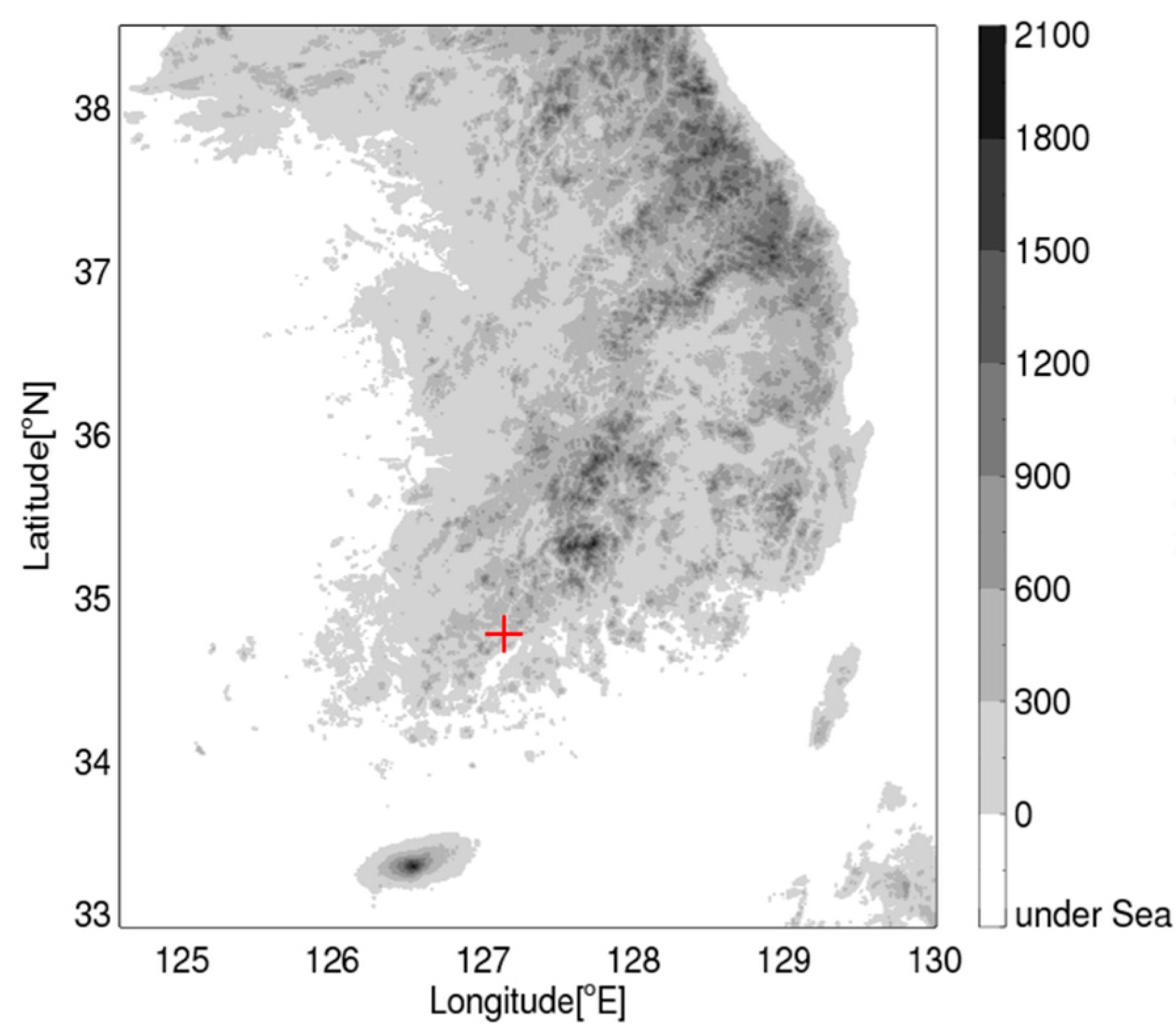

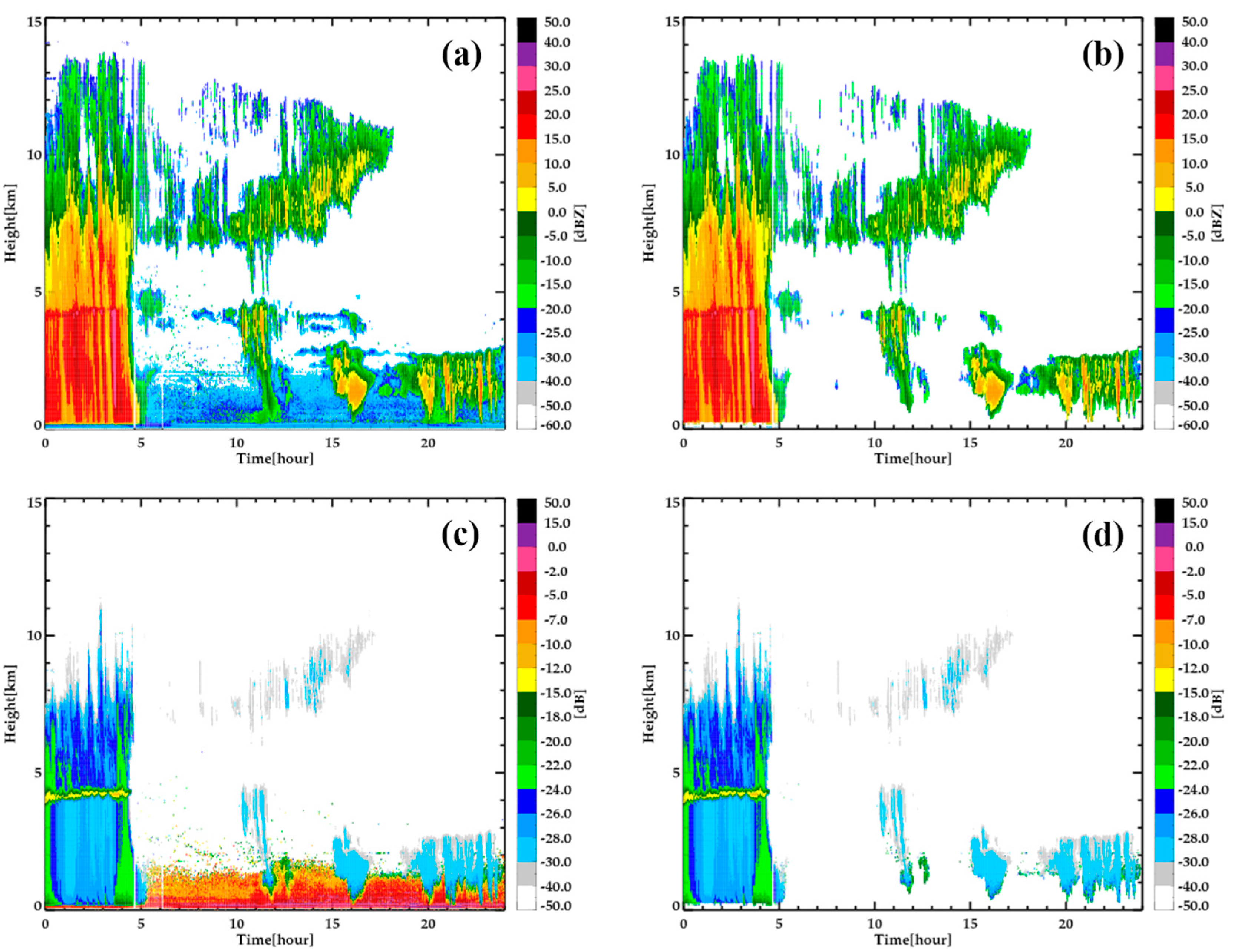


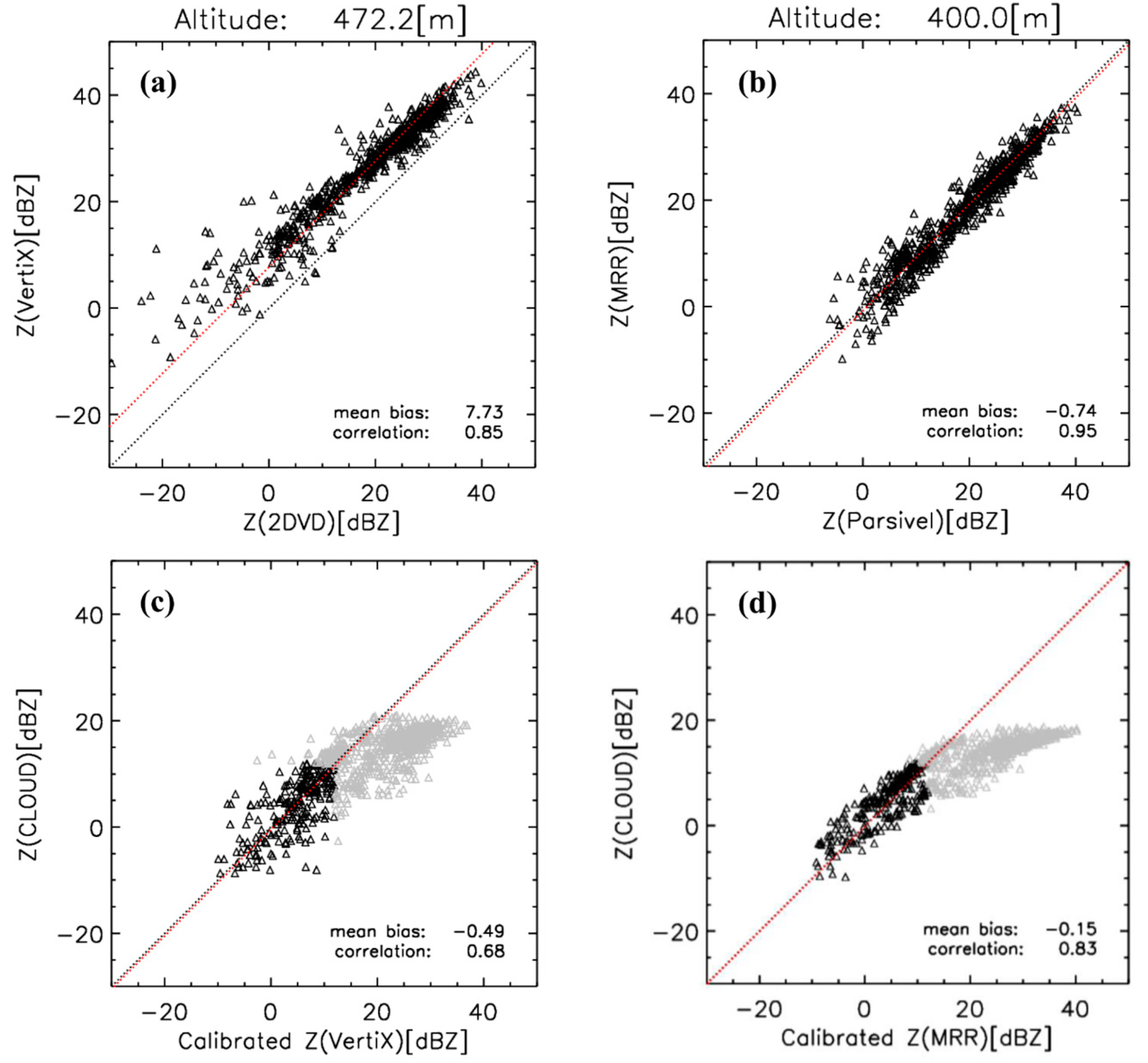

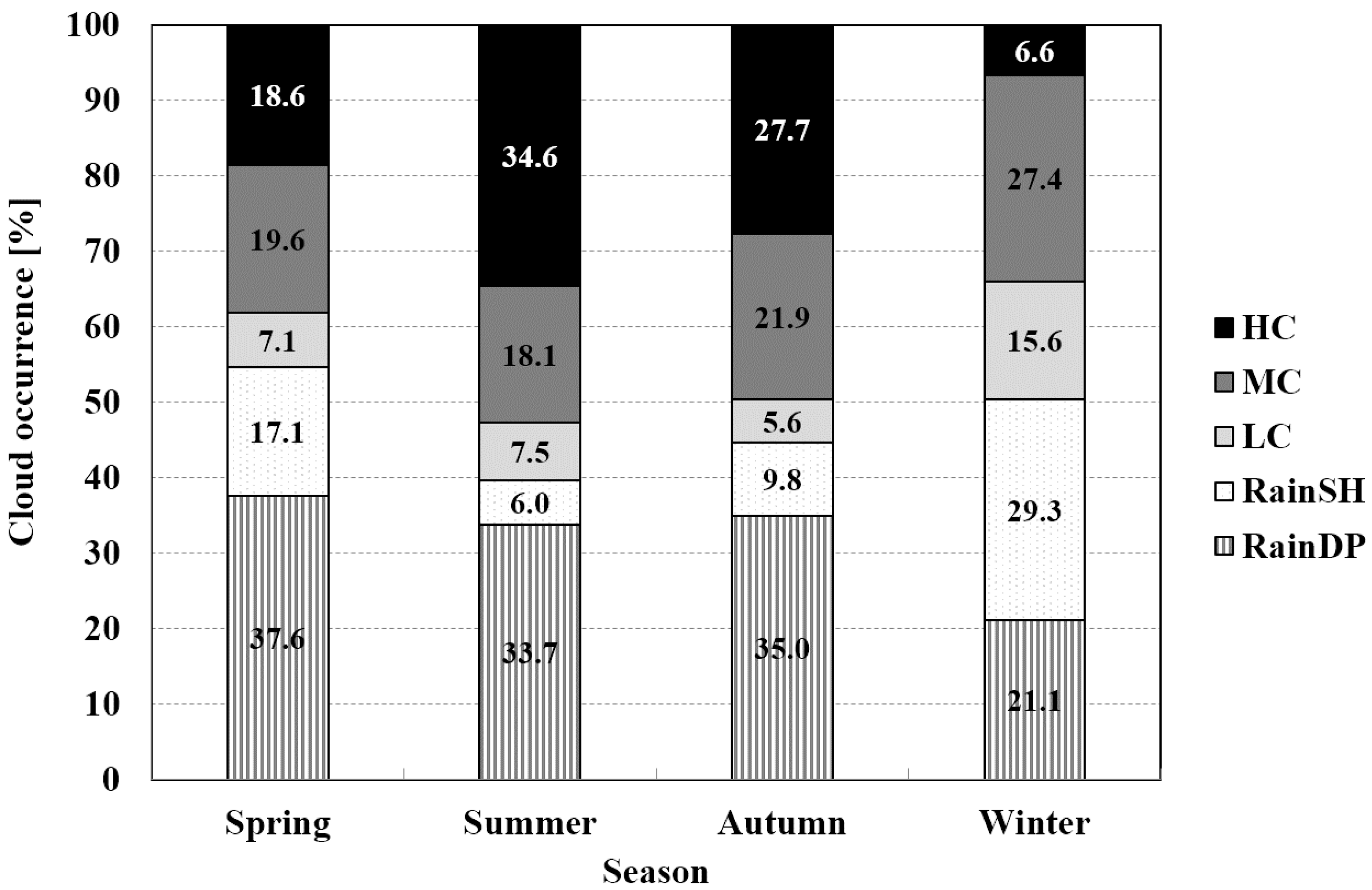
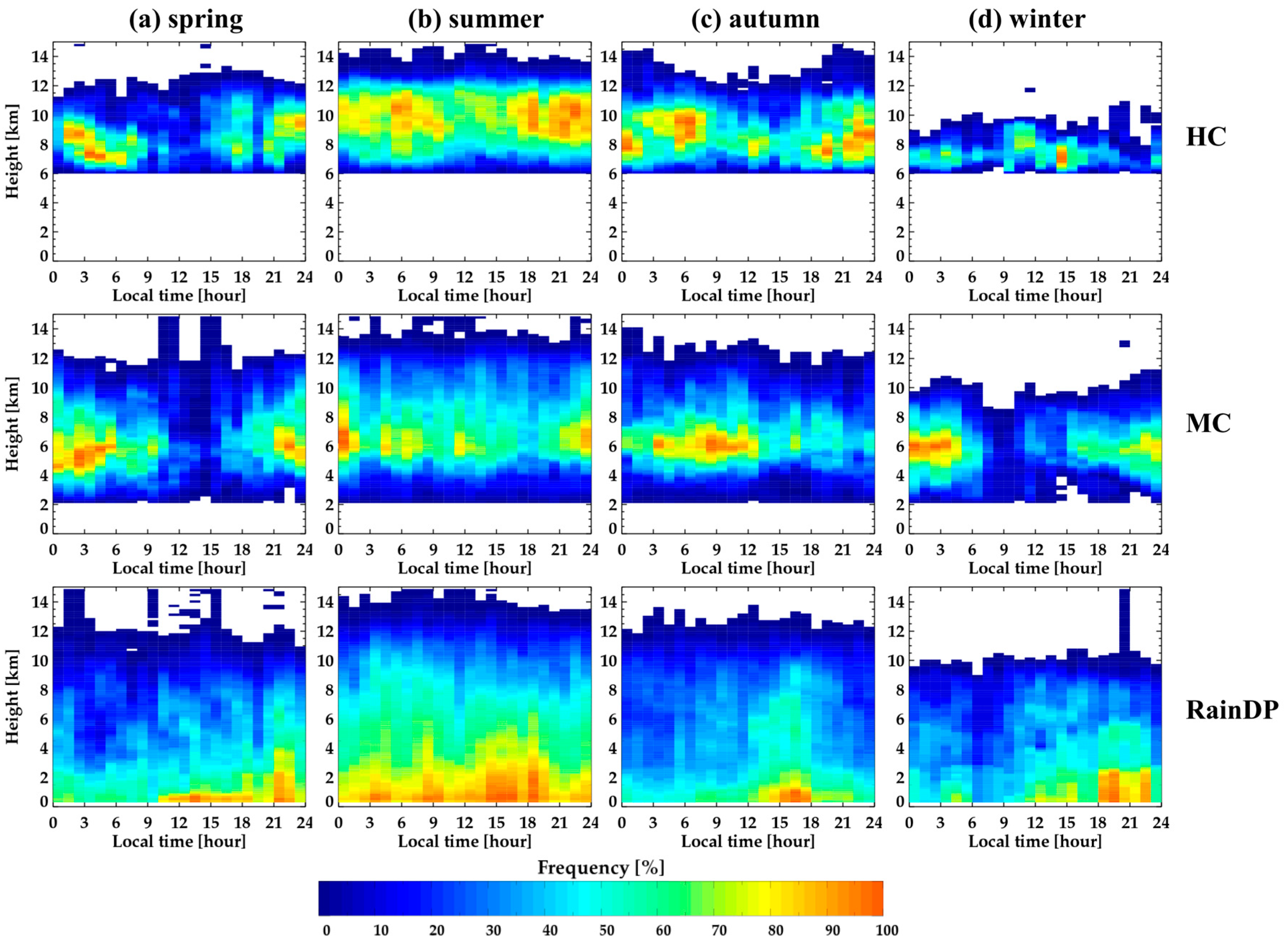
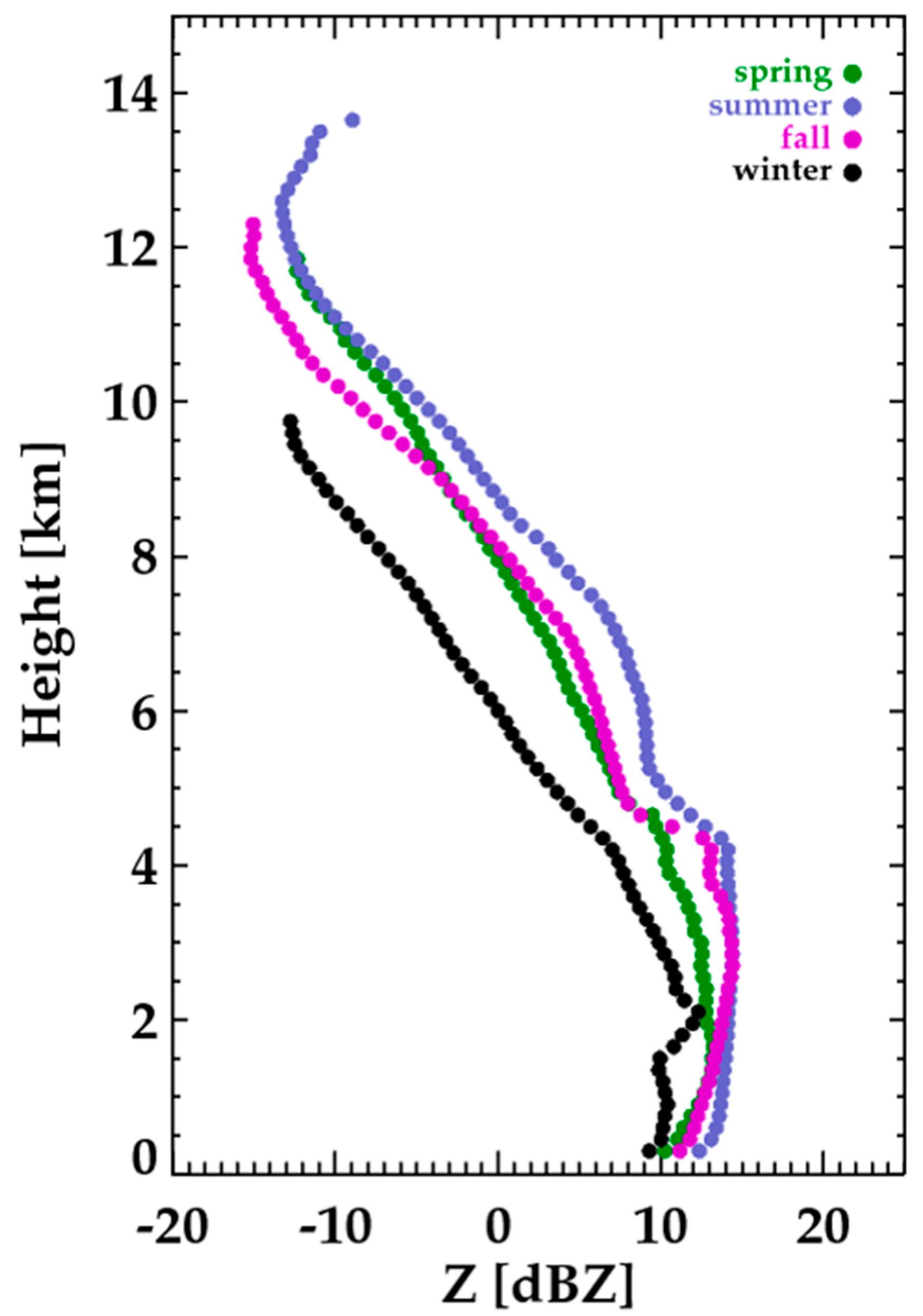
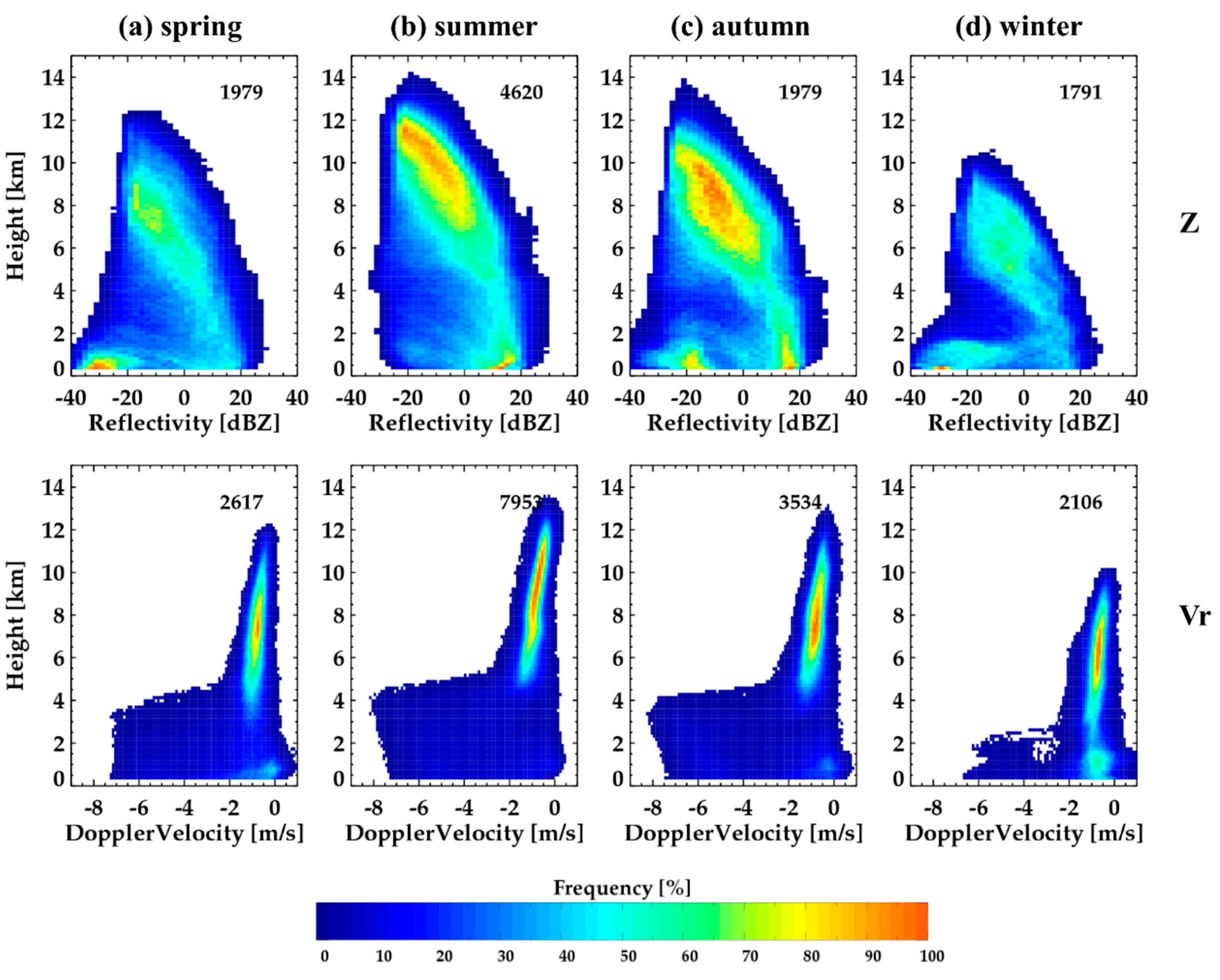

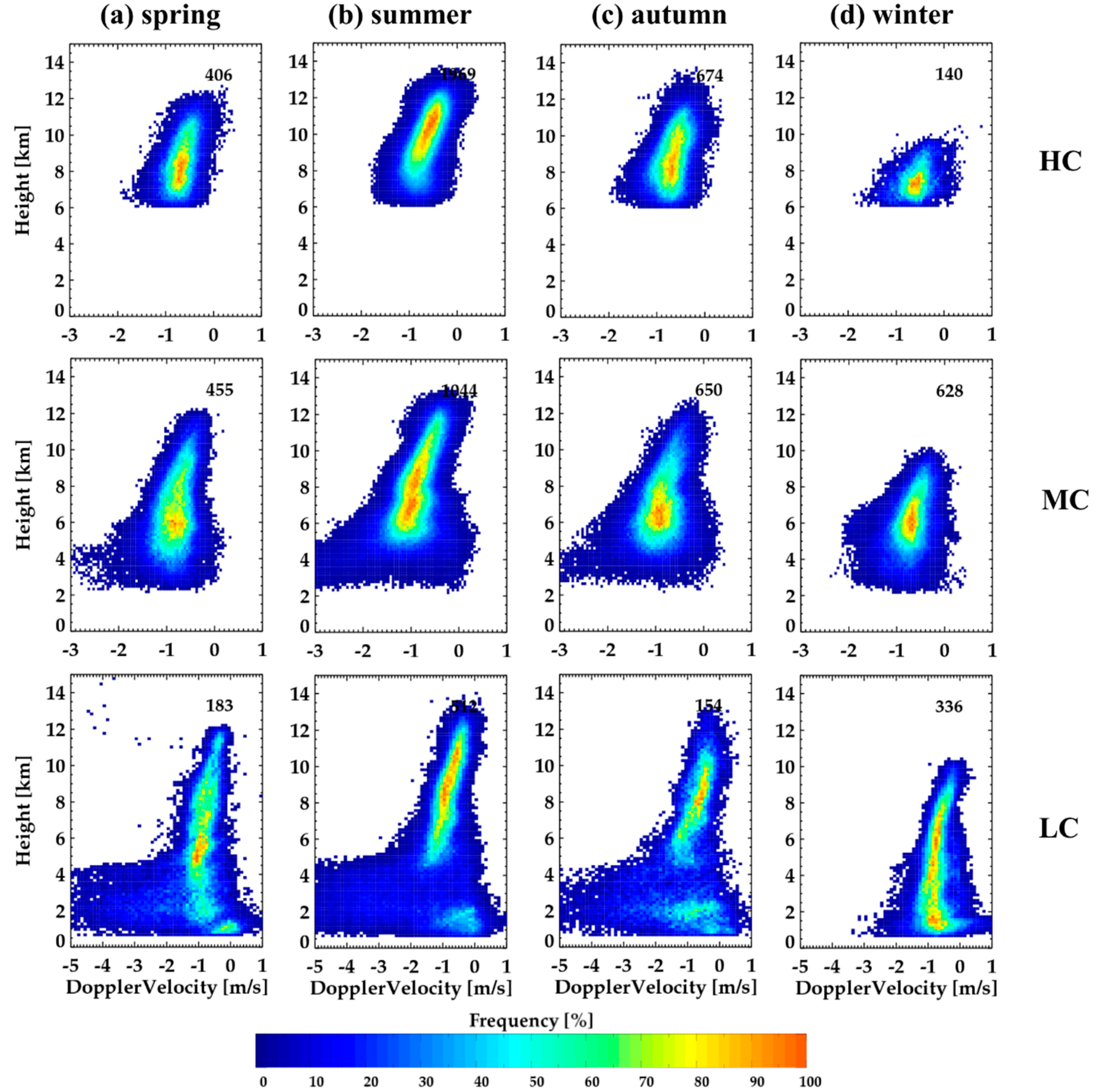
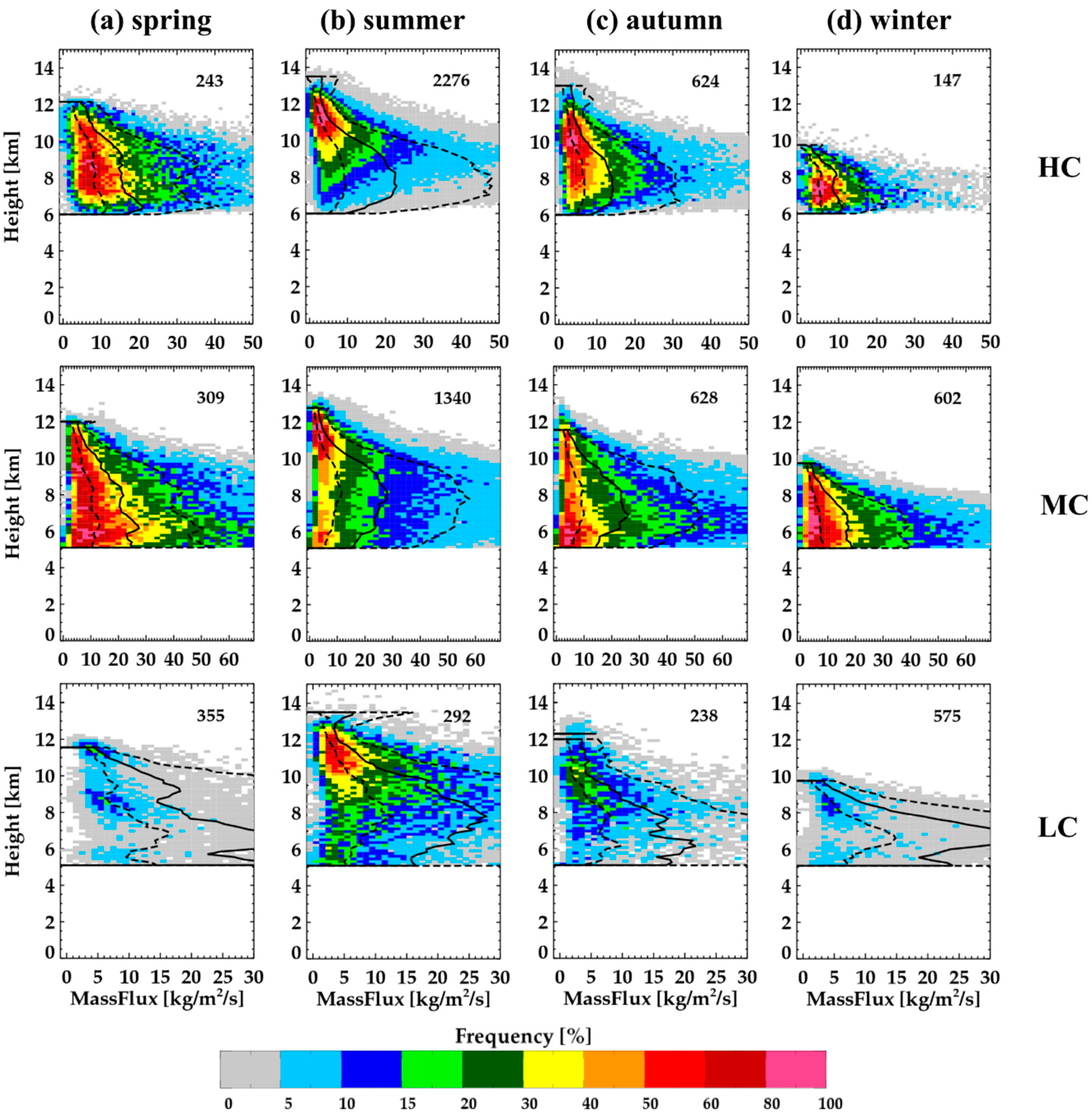
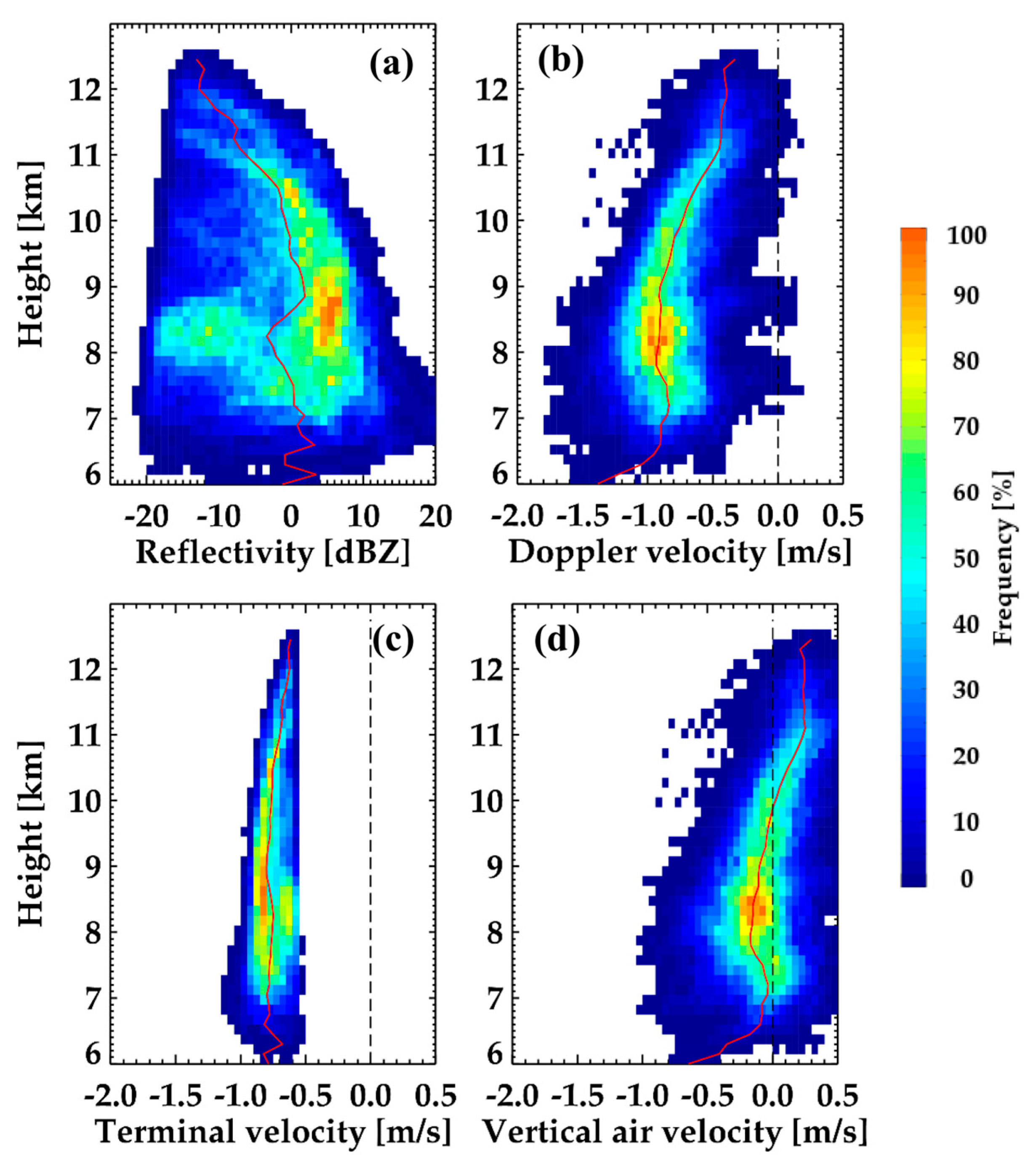
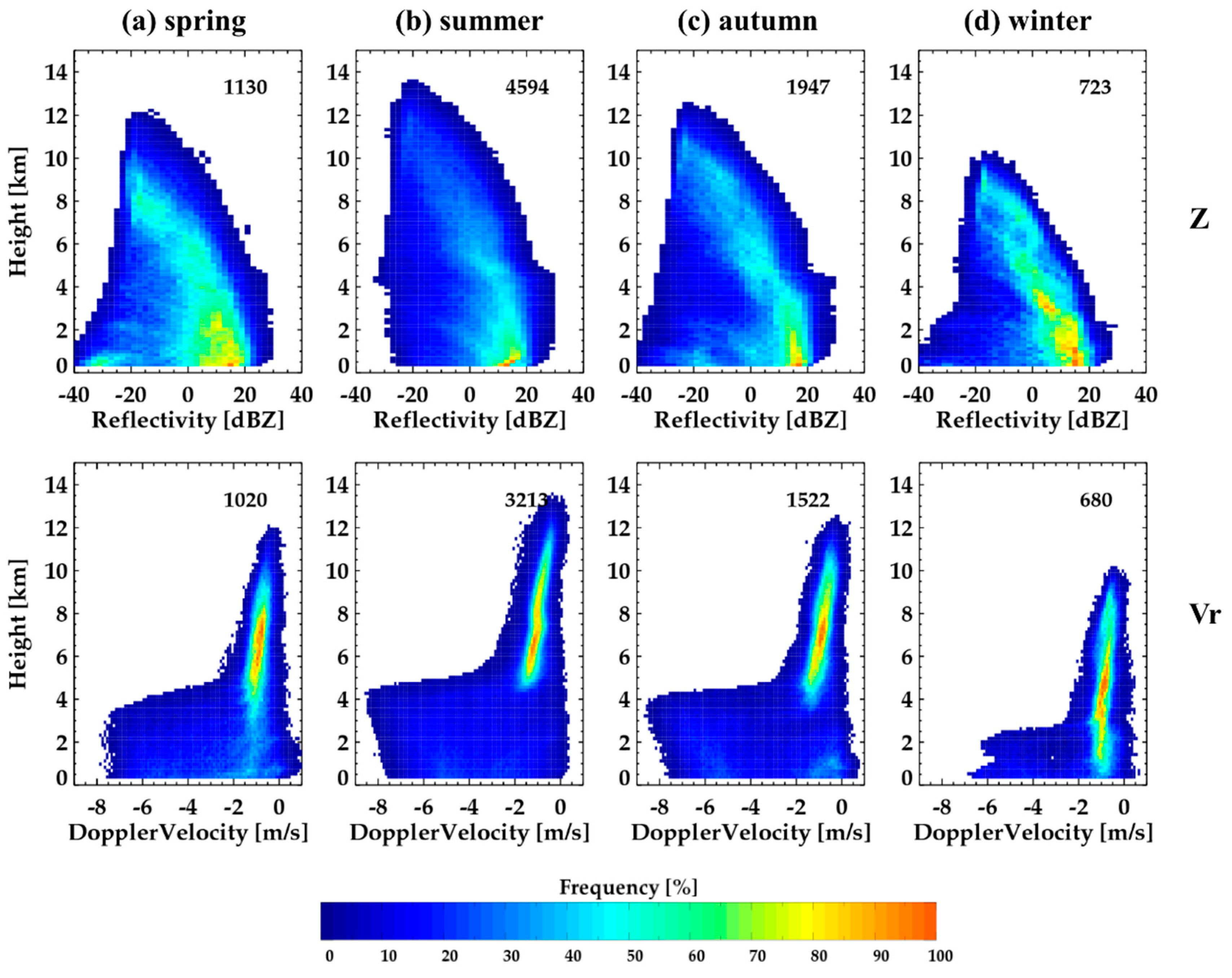
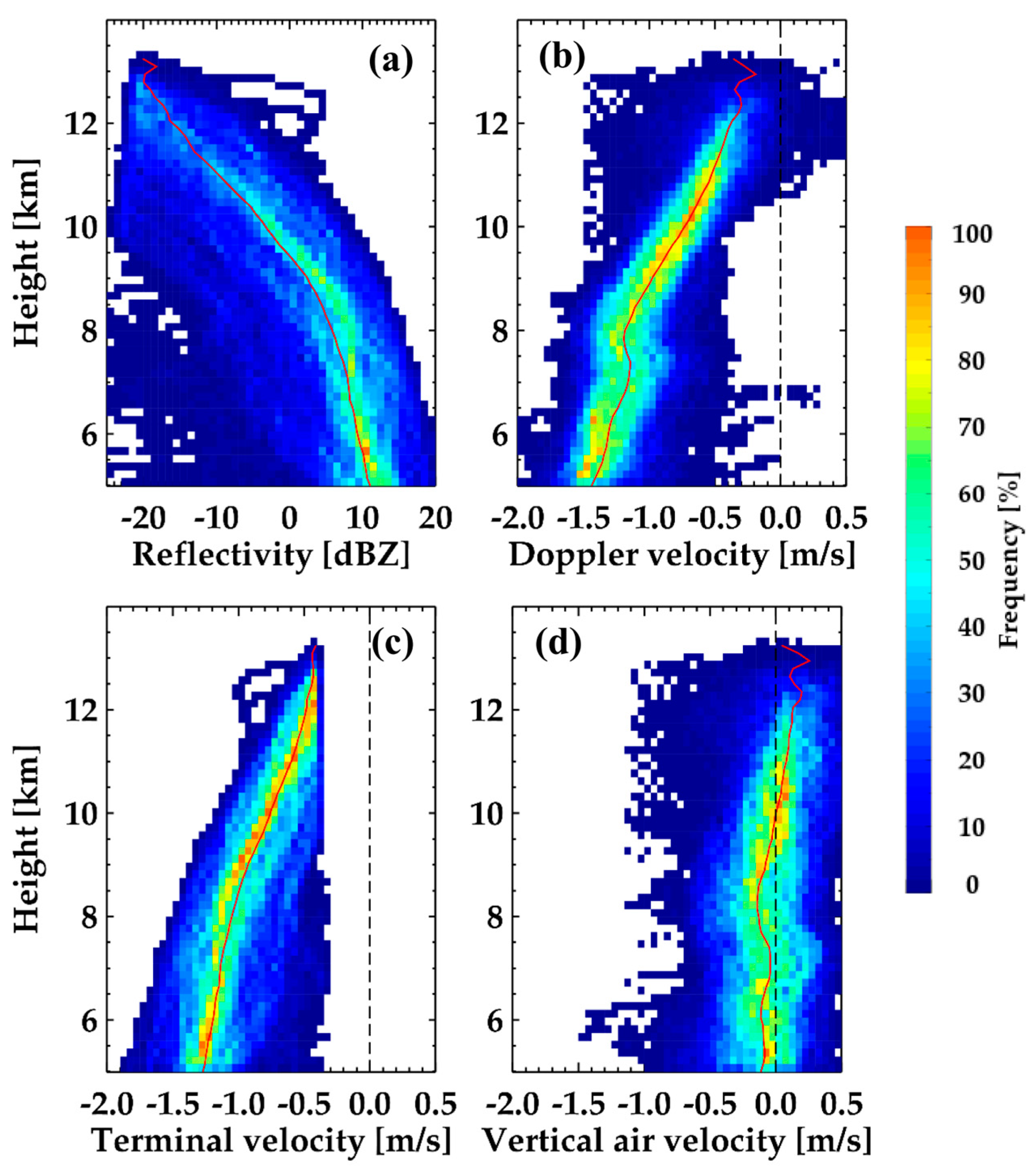
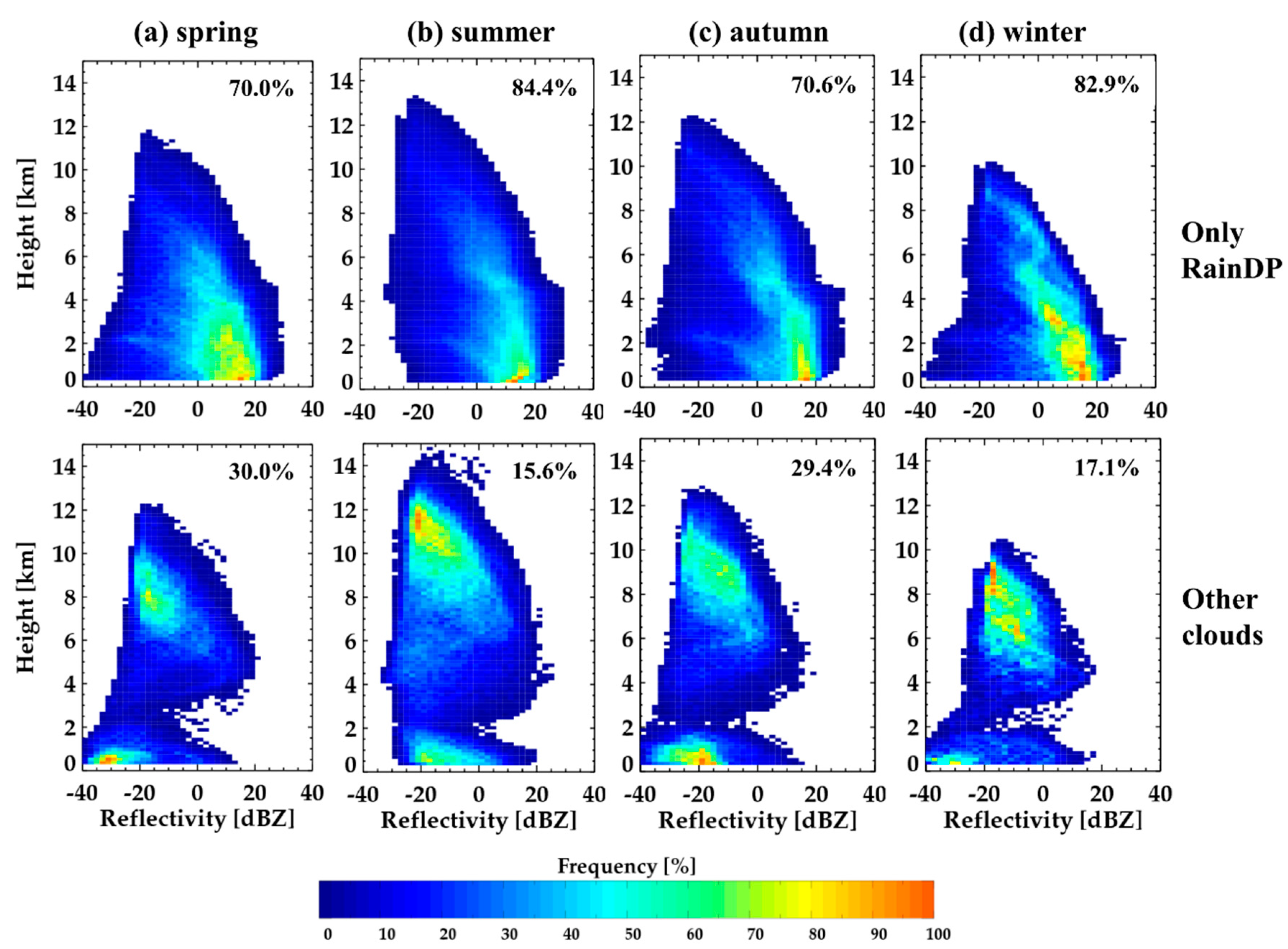
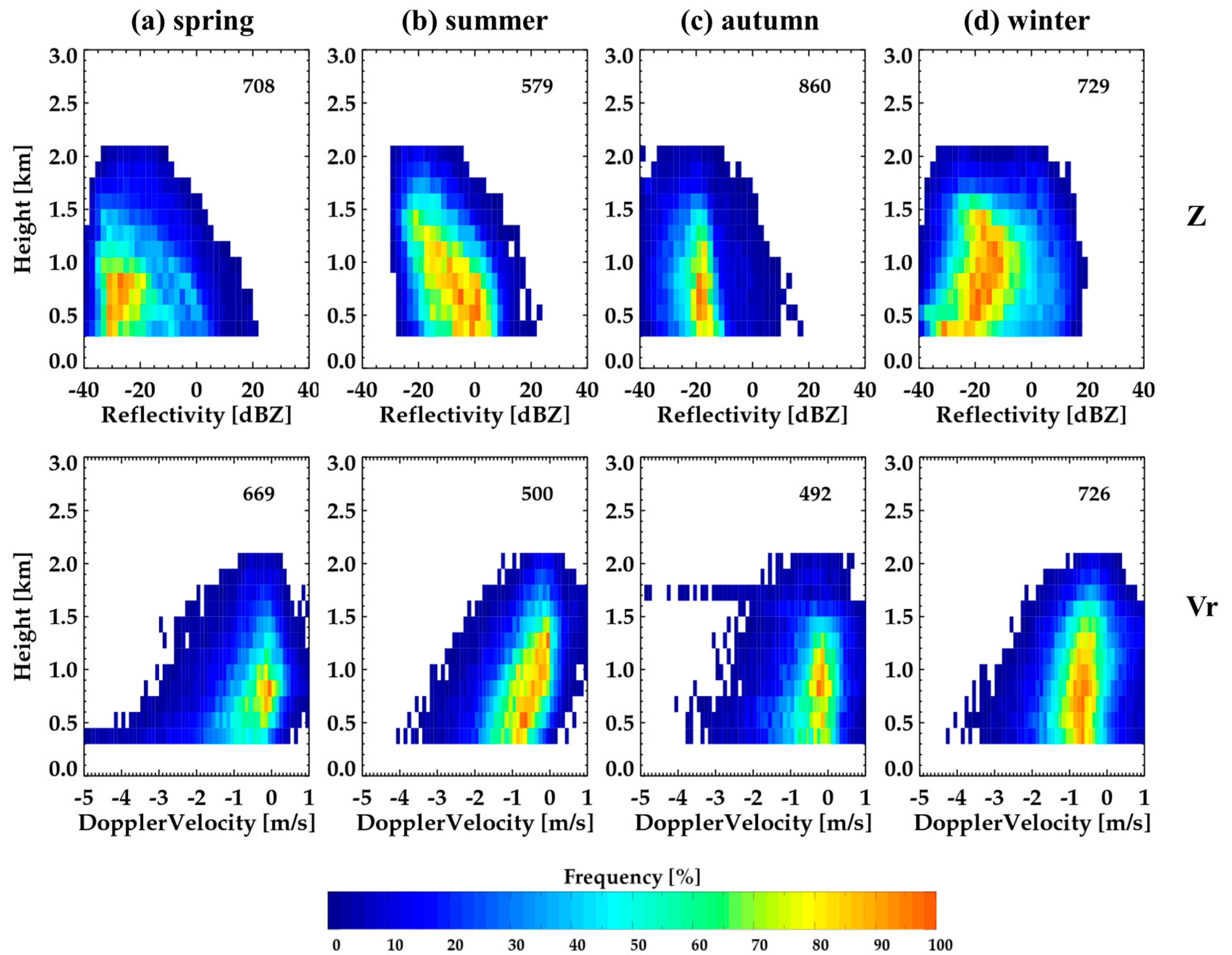
| Parameters | Values | |
|---|---|---|
| Transmitter | Type | Magnetron |
| Peak power | ≥15 kW | |
| Frequency | 33.44 GHz | |
| Pulse width | 200 ns | |
| Pulse repetition frequency | 3.3 kHz | |
| Antenna | Type | Parabola |
| Diameter | 1.5 m | |
| Beamwidth | 0.42° | |
| Scanning strategy | Number of gates | 1000 |
| Sampling number | 126, 256 | |
| Gate spacing | 15 m | |
| Maximum observational range | 15 km | |
| Scan mode | Plan position indicator (PPI), Vertical pointing (VP) | |
| Time resolution (real elapsed time of PPI, VP) | 1 min (30 s, 45 s) | |
| Polarization mode | Single transmitting dual receiving |
| No. | Periods (UTC) | Instrument | No. | Periods (UTC) | Instrument |
|---|---|---|---|---|---|
| 1 | 1800–2359 16 June 2014 | P-M | 19 | 0000–1559 20 Aug. 2014 | P-M |
| 2 | 0000–0459 17 June 2014 | P-M | 20 | 1900–2359 27 Aug. 2014 | P-M |
| 3 | 0400–1459 21 June 2014 | P-M | 21 | 0000–0759 28 Aug. 2014 | P-M |
| 4 | 0000–1559 2 July 2014 | 2-V | 22 | 0400–2259 2 Sep. 2014 | P-M |
| 5 | 1300–1859 5 July 2014 | 2-V | 23 | 0600–0859 12 Sep. 2014 | P-M |
| 6 | 0000–0359 6 July 2014 | P-M | 24 | 0500–2059 23 Sep. 2014 | P-M |
| 7 | 0000–1059 9 July 2014 | P-M | 25 | 0500–1659 29 Sep. 2014 | P-M |
| 8 | 1400–2359 12 July 2014 | P-M | 26 | 0500–2359 12 Oct. 2014 | P-M |
| 9 | 0900–1859 16 July 2014 | 2-V | 27 | 1200–2259 12 Apr. 2015 | P-M |
| 10 | 0300–0459 17 July 2014 | 2-V | 28 | 1000–1659 13 Apr. 2015 | P-M |
| 11 | 1200–2359 18 July 2014 | 2-V | 29 | 0700–1059 22 Aug. 2015 | P-M |
| 12 | 0500–0959 28 July 2014 | P-M | 30 | 0800–1459 16 Sep. 2015 | P-M |
| 13 | 0900–1459 1 Aug 2014 | P-M | 31 | 0000–1259 23 Sep. 2015 | P-M |
| 14 | 0000–2359 2 Aug 2014 | P-M | 32 | 0000–2359 30 Sep. 2015 | P-M |
| 15 | 1400–2259 14 Aug. 2014 | 2-V | 33 | 0000–0859 1 Oct. 2015 | P-M |
| 16 | 1600–1759 17 Aug. 2014 | 2-V | 34 | 0500–1259 6 Apr. 2016 | P-M |
| 17 | 0000–2159 18 Aug. 2014 | 2-V | 35 | 0000–0459 24 May 2016 | P-M |
| 18 | 0300–1559 19 Aug. 2014 | P-M | 36 | 1100–2359 27 May 2016 | P-M |
| Parameter | Value |
|---|---|
| Radar frequency | Ka-band (33.4 GHz) |
| K-band (24.0 GHz) | |
| X-band (9.3 GHz) | |
| Environment temperature | 10 °C |
| Radar elevation angle | 90° |
| Model hydrometeor type | Raindrop |
| Shape model of raindrop | Thurai et al. [36] |
| Canting angle of raindrops | Gaussian distribution with mean μ = 0° and standard deviation σ = 10° |
| Cloud Type | Criteria | |
|---|---|---|
| High cloud (HC) | Hb ≥ 6 km | |
| Middle cloud (MC) | 2 km ≤ Hb < 6 km | |
| Low cloud (LC) | 300 m < Hb < 2 km | |
| Rain | Shallow (RainSH) | Ht < 2 km Hb = 300 m |
| Deep (RainDP) | Ht ≥ 2 km Hb = 300 m | |
| [%] | Spring | Summer | Autumn | Winter | Total |
|---|---|---|---|---|---|
| HC | 1.21 | 5.41 | 2.38 | 0.34 | 9.34 |
| MC | 1.27 | 2.83 | 1.88 | 1.42 | 7.41 |
| LC | 0.46 | 1.18 | 0.48 | 0.81 | 2.93 |
| RainSH | 1.11 | 0.93 | 0.84 | 1.51 | 4.40 |
| RainDP | 2.44 | 5.27 | 3.00 | 1.09 | 11.81 |
| Total | 6.51 | 15.62 | 8.59 | 5.18 | 35.90 |
© 2020 by the authors. Licensee MDPI, Basel, Switzerland. This article is an open access article distributed under the terms and conditions of the Creative Commons Attribution (CC BY) license (http://creativecommons.org/licenses/by/4.0/).
Share and Cite
Ye, B.-Y.; Jung, E.; Shin, S.; Lee, G. Statistical Characteristics of Cloud Occurrence and Vertical Structure Observed by a Ground-Based Ka-Band Cloud Radar in South Korea. Remote Sens. 2020, 12, 2242. https://doi.org/10.3390/rs12142242
Ye B-Y, Jung E, Shin S, Lee G. Statistical Characteristics of Cloud Occurrence and Vertical Structure Observed by a Ground-Based Ka-Band Cloud Radar in South Korea. Remote Sensing. 2020; 12(14):2242. https://doi.org/10.3390/rs12142242
Chicago/Turabian StyleYe, Bo-Young, Eunsil Jung, Seungsook Shin, and GyuWon Lee. 2020. "Statistical Characteristics of Cloud Occurrence and Vertical Structure Observed by a Ground-Based Ka-Band Cloud Radar in South Korea" Remote Sensing 12, no. 14: 2242. https://doi.org/10.3390/rs12142242
APA StyleYe, B.-Y., Jung, E., Shin, S., & Lee, G. (2020). Statistical Characteristics of Cloud Occurrence and Vertical Structure Observed by a Ground-Based Ka-Band Cloud Radar in South Korea. Remote Sensing, 12(14), 2242. https://doi.org/10.3390/rs12142242






